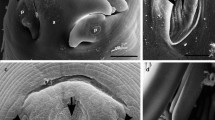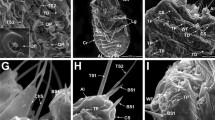Abstract
ADULTS of Drosophila spp. trapped at frequent intervals in Nature at Dalkeith, Midlothian, were dissected to follow the development of the ovaries, and occasionally the testes, during autumn, winter and spring. The flies dissected were D. subobscura Coll. (19 males, 338 females), D. obscura Fin. (17 males, 92 females), D. silvestris Bas. (41 males, 34 females), D. tristis Fln. (2 males, 7 females), D. funebris (Fabr.) (3 males, 11 females), and D. cameraria Hal. (3 females). During these dissections a few specimens of the first three species were observed to be infested with a nematode, provisionally identified as Aphelenchulus sp. (Allantonematidae Chtw. and Chtw., 1937), probably new. The numbers of dissected flies are shown in Table 1, the figures in parentheses being the numbers of those infested.
This is a preview of subscription content, access via your institution
Access options
Subscribe to this journal
Receive 51 print issues and online access
$199.00 per year
only $3.90 per issue
Buy this article
- Purchase on Springer Link
- Instant access to full article PDF
Prices may be subject to local taxes which are calculated during checkout
Similar content being viewed by others
References
Goodey, T., J. Helminth., 8, (3), 123 (1930).
Zwaluwenburg, R. H. van, Bull. Hawaii. Sug. Assoc., Ent. Ser., 20, 1 (1928).
Gershenson, S., Drosophila Inform. Serv., 11, 44 (1939).
Author information
Authors and Affiliations
Rights and permissions
About this article
Cite this article
BASDEN, E., GOODEY, J. A Nematode Parasite of Drosophila . Nature 175, 431–432 (1955). https://doi.org/10.1038/175431b0
Issue Date:
DOI: https://doi.org/10.1038/175431b0
Comments
By submitting a comment you agree to abide by our Terms and Community Guidelines. If you find something abusive or that does not comply with our terms or guidelines please flag it as inappropriate.



